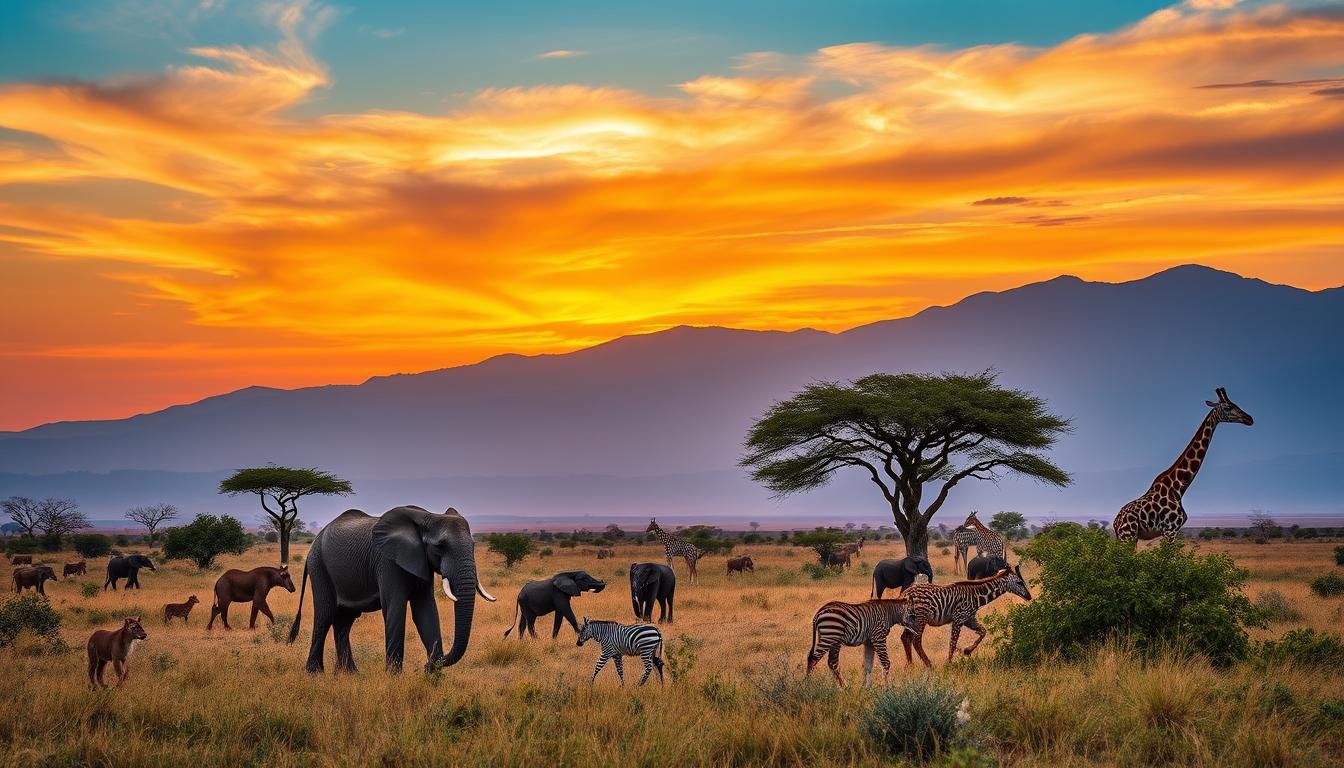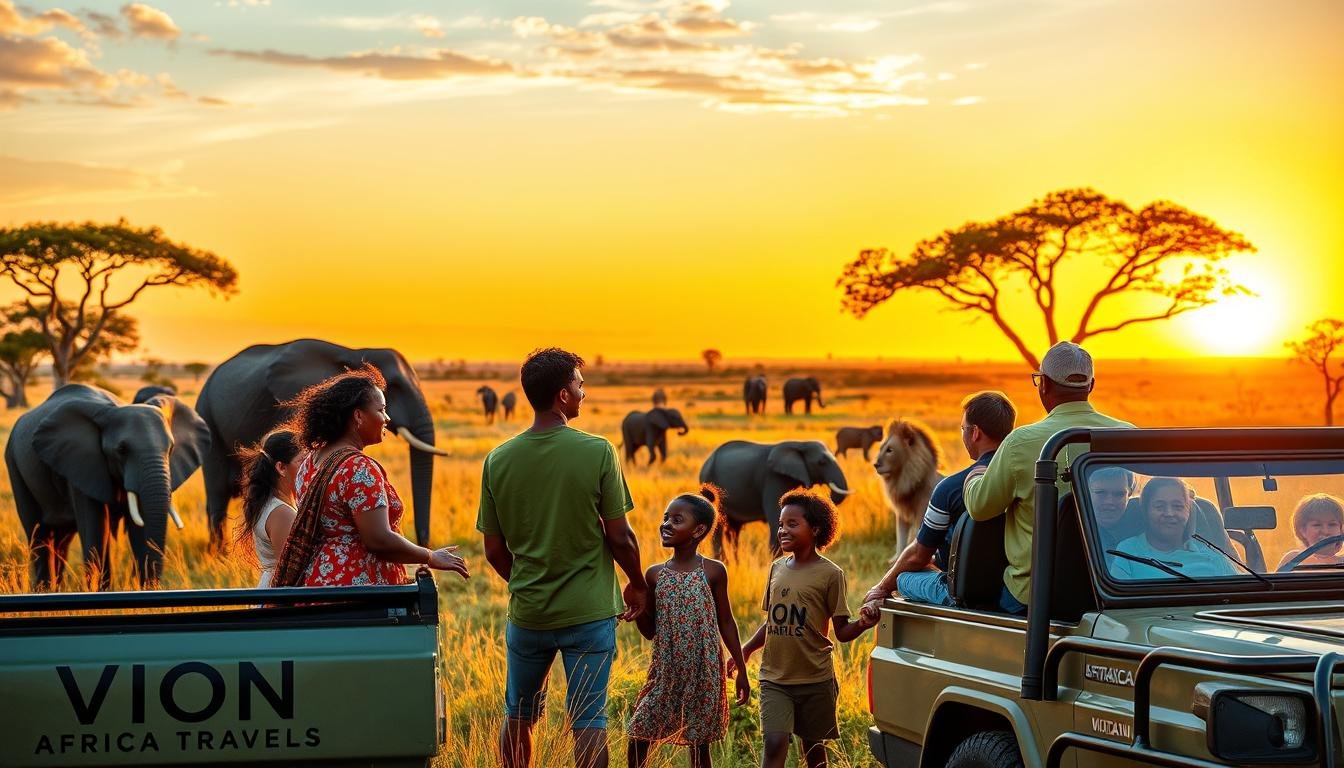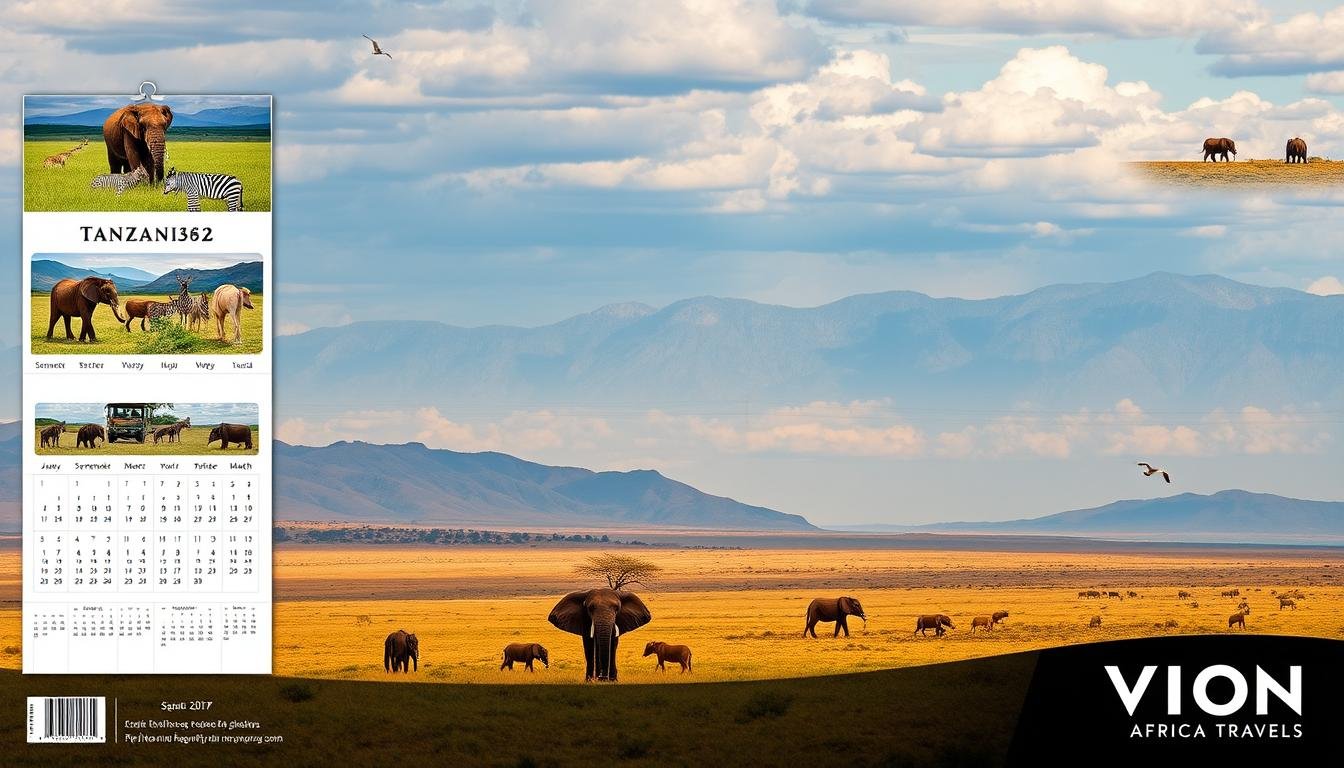Planning a safari in Tanzania needs careful thought about the best time to go. As experts in Tanzanian travel, we’re here to guide you. We’ll help you plan an unforgettable African adventure. This guide covers seasonal changes and the best times for wildlife viewing.
Key Takeaways
- Discover the distinct dry and wet seasons in Tanzania and how they impact wildlife movement and visibility.
- Explore the best times to witness the renowned Great Migration and prime calving season in the Ndutu region.
- Understand the advantages and considerations of traveling during peak and off-peak seasons.
- Gain insights into the unique safari destinations, from the Serengeti National Park to the Ngorongoro Crater.
- Prepare for your safari with information on ideal clothing, health precautions, and booking considerations.
Understanding Tanzanian Seasons
Tanzania’s diverse landscape is shaped by two distinct seasons: the dry season and the wet season. Knowing these seasons is key for planning your Tanzania safari. It ensures an unforgettable wildlife experience.
Dry Season vs Wet Season
The dry season in Tanzania lasts from June to October. It’s the best time for ideal weather for Tanzania safari lovers. During this time, the vegetation is sparse, and wildlife gathers around limited water sources. This makes it easier to spot and observe these magnificent creatures.
In contrast, the wet season, from November to May, brings lush greenery. Wildlife spreads out to take advantage of the abundant vegetation and dispersed water sources. This makes them harder to locate but offers a more natural and less crowded safari experience.
Impact on Wildlife Movement
- Dry season: Wildlife is drawn to reliable water sources, leading to more concentrated sightings and increased visibility.
- Wet season: Wildlife spreads out to take advantage of the abundant vegetation and dispersed water sources, making them harder to locate but offering a more natural and less crowded safari experience.
Whether you choose to explore Tanzania during the dry or wet season, each offers its own charm. You’ll get to witness the incredible diversity of the region’s wildlife.
“The rhythm of the seasons is one of the great secrets of the Serengeti.” – Reinhold Messner
Best Time for Wildlife Viewing
Timing is key to see Tanzania’s amazing wildlife. The country’s seasons bring different chances for incredible sightings. The Tanzania migration season is one of the highlights.
The Great Migration
The wildebeest migration in Tanzania is breathtaking. Thousands of wildebeest, zebras, and other animals travel across the Serengeti. They search for new grass and water.
The best time to see this is between July and October. During this time, the animals cross rivers, chased by predators.
This is the best time to see wildlife in Tanzania. The migration shows nature’s power and drama. Seeing the huge herds is a humbling experience.
Calving Season in Ndutu
The calving season in Ndutu is also great for wildlife watching. It happens from December to March. Thousands of wildebeest and zebra calves are born, attracting predators like lions and cheetahs.
This is a special time to see life’s cycle. Newborn calves take their first steps and face survival challenges.
Whether you’re interested in the Tanzania migration or the Ndutu calving, Tanzania is a top spot for wildlife watching. Knowing the best times helps you see the most amazing sights Tanzania has.
Rainy Seasons and Their Effects
Tanzania has a varied climate, and knowing about its rainy seasons is key for planning a safari. We’ll look at how the short and long rains affect your safari plans. This will help you pick the best months for your Tanzania safari.
Short Rains (November-December)
The short rainy season, or “Vuli” rains, happens from November to December. During this time, the landscape turns green and lush. Wildlife viewing might be harder because of the thick foliage.
Yet, this period lets you see the ecosystem come back to life. The extra water sources attract many animals, offering great safari sights.
Long Rains (March-May)
The long rainy season, or “Masika” rains, is from March to May. This wet period can make some areas hard to reach because of the rain and mud. But, the green landscapes and newborn animals, like wildebeest calves, make for amazing wildlife watching.
It’s important to plan carefully and be flexible during the long rains. This way, you can make the most of your safari.
Knowing about Tanzania’s rainy seasons and their impact on wildlife and travel is vital for planning your safari. By understanding the pros and cons of each season, you can pick the best months for your safari. This ensures your trip meets your expectations.
Peak Season: When to Visit
Visiting Tanzania during the peak safari season is an unforgettable adventure. The dry season brings clear skies and dry land. This makes it the perfect time to see wildlife in their natural homes.
Advantages of Traveling During Peak Season
The peak season, from June to October, is the best time to see the Great Migration. Millions of wildebeests, zebras, and other animals migrate across the Serengeti. This is a great time for wildlife viewing as animals gather in large numbers.
The dry weather also means clear views. You can see the animals against the golden savannas. It’s a perfect setting for amazing photos.
Tourists and Crowds
The Tanzania peak safari season draws many visitors. This means you’ll see more people at popular spots. But, with good planning and help from safari experts, you can still have a great time.
“The peak safari season in Tanzania offers a unique blend of exceptional wildlife viewing and the opportunity to witness the Great Migration, but it also means navigating larger crowds. With the right planning and guidance, you can make the most of this remarkable time to explore the wonders of the Tanzanian wilderness.”
Off-Peak Advantages
The off-peak months in Tanzania have their own perks. They offer budget-friendly options and unique wildlife sightings. These periods can make your safari unforgettable.
Budget Travel Benefits
Traveling off-peak in Tanzania can save you money. Prices for accommodations, tours, and flights drop. This makes safaris more affordable for everyone.
Unique Wildlife Sightings
Off-peak months have their own wildlife wonders. You might see the calving season in Ndutu or rare predators. These sightings make your safari special.
| Off-Peak Season Advantages | Peak Season Advantages |
|---|---|
|
|
Off-peak seasons in Tanzania are great for budget travelers or wildlife enthusiasts. They offer unique experiences. Plan your safari to fit your budget and preferences for a memorable trip.
Safari Destinations Overview
Planning a Tanzania safari means exploring the country’s top spots for a memorable wildlife adventure. The Serengeti National Park and the Ngorongoro Crater are two highlights. Each offers a unique experience and the best time to see wildlife.
Serengeti National Park
The Serengeti is famous for its diverse wildlife and the Great Migration. Millions of wildebeest, zebra, and gazelle migrate here. The best time to see this is between June and October.
Ngorongoro Crater
The Ngorongoro Crater is a UNESCO World Heritage Site and a key spot for Tanzania safari planning. It’s home to many animals, including the rare black rhinoceros. The best time to visit is from June to October, when animals gather at water sources.
Tanzania has many safari options, from the Serengeti to the Ngorongoro Crater. By choosing the right time, you can see the amazing wildlife and landscapes. This country offers unforgettable safari experiences.
Climate Considerations
When planning your [https://altezzatravel.com] Tanzania safari, it’s crucial to consider the climate and temperature ranges throughout the year. Understanding the ideal weather conditions and packing the right gear can significantly enhance your safari experience.
Temperature Ranges Year-Round
Tanzania’s climate is generally warm and sunny. Average temperatures range from the mid-70s Fahrenheit (around 24°C) to the mid-90s Fahrenheit (around 35°C). The coastal regions tend to be slightly more humid. Central and northern areas can experience cooler temperatures, especially during the early mornings and evenings.
The ideal weather for Tanzania safari typically occurs during the dry season, which runs from June to October. During this time, the days are sunny and the nights are pleasantly cool. It’s an excellent time for Tanzania safari travel tips.
Ideal Clothing for Safari
- Lightweight, breathable fabrics like cotton or linen are recommended for the daytime.
- Bring long-sleeved shirts and pants to protect against mosquitoes and the sun.
- A light jacket or sweater for the cooler evenings and early mornings.
- Sturdy, closed-toe shoes or hiking boots for traversing the varied terrain.
- Accessories like a wide-brimmed hat, sunglasses, and sun protection are essential.
By packing the right clothing and being prepared for the ideal weather for Tanzania safari, you can ensure a comfortable and enjoyable Tanzania safari travel tips experience.
| Season | Average Temperature | Ideal Clothing |
|---|---|---|
| Dry Season (June-October) | Mid-70s to mid-90s Fahrenheit (24-35°C) | Lightweight, breathable fabrics; long sleeves and pants; light jacket/sweater |
| Wet Season (November-May) | Mid-60s to mid-90s Fahrenheit (18-35°C) | Layers to accommodate temperature changes; rain gear for the rainy periods |
Booking Safari Tours
Planning your Tanzania safari adventure requires careful timing. The right timing can greatly affect your experience and cost. Knowing how to get the best deals and plan your trip can make it unforgettable.
Planning in Advance
Booking early is key for a great Tanzania safari. Reserving your tour months before can save you money. It also ensures you get the best spots and accommodations.
This way, you can tailor your trip perfectly. You’ll get the best advice for your safari travel.
Last-Minute Deals
But, there are also last-minute deals to look out for. Tour operators might offer discounts close to the trip date. They want to fill any empty spots.
By being flexible and watching for these deals, you might save money. This way, you can enjoy a safari without breaking the bank.
Choosing the right booking strategy depends on your preferences and budget. Whether you plan ahead or look for last-minute deals, stay informed. This will help you find the perfect safari experience in Tanzania.
Family Safaris: Best Time to Travel
Planning a Tanzania safari for families requires special thought. The best time to go depends on school breaks, weather, and fun activities for kids.
Considerations for Family Travel
School holidays are the best times for families to visit Tanzania. Kids can enjoy the safari without worrying about school. Summer (June to August) and the Christmas/New Year’s holidays are great times to travel.
Kid-Friendly Safari Experiences
Choosing the right safari for kids is key. Lodges and tour operators in Tanzania offer fun activities like scavenger hunts and educational game drives. These activities make the safari exciting and educational for kids.
Also, the best months for Tanzania safari are during the Tanzania safari season. The weather is nice, and animals are more active. This makes the trip fun for everyone.
Thinking about family needs makes the Tanzania safari season better for everyone. It creates lasting memories and a strong bond with Tanzania’s wildlife and landscapes.
Photographic Safaris
Tanzania is a top spot for photography lovers. It has diverse landscapes and lots of wildlife. The best time for a photo safari greatly affects your photos. Let’s look at the best light times and places to take amazing pictures in Tanzania.
Best Light Conditions for Photography
The golden hours, at sunrise and sunset, are perfect for photos. They bring a warm, soft light that makes details stand out. Also, cloudy days give even light, without harsh shadows, making scenes look natural.
Notable Locations for Photography
Tanzania’s wide range of landscapes offers many photo chances. The Serengeti National Park is great for big wildlife shots, thanks to its open plains and the wildebeest migration. The Ngorongoro Crater, a UNESCO site, has beautiful views and a variety of animals.
Hot air balloon rides over the Serengeti give a unique view of the land and animals. Walking safaris in Tarangire or Selous let you get close to plants and animals.
Knowing the best light and Tanzania’s famous photo spots can help you take stunning pictures. Whether you’re going during the busy season or not, there’s always something to capture.
Adventure and Activities
Tanzania is famous for its wildlife, but it also has many exciting safari activities. You can soar over the savanna in a hot air balloon or go on a walking safari. These activities make your Tanzania safari even more special.
Hot Air Balloon Safaris
Hot air balloon safaris give you a stunning view of Tanzania’s landscapes. In the early morning, you’ll see the Serengeti National Park from above. It’s a magical time to watch the sun light up the hills and see the wildlife below.
This view is unlike any other. You’ll see the Tanzania safari travel tips in a new way, including the Great Migration.
Walking Safaris
Walking safaris let you experience the wild up close. You’ll walk through the wilderness with a guide. This way, you can see plants and animals up close and learn about the ecosystem.
These safaris are great during the dry season. The wildlife is easier to see, and it’s a quieter time to explore.
| Safari Activity | Best Season | Notable Locations |
|---|---|---|
| Hot Air Balloon Safaris | Year-round, with ideal conditions during the dry season | Serengeti National Park, Ngorongoro Crater |
| Walking Safaris | Dry season (June to October) | Serengeti National Park, Tarangire National Park |
Whether you’re flying over the Serengeti or walking through it, Tanzania’s adventures are unforgettable. They add excitement to your Tanzania safari travel tips.
Cultural Experiences
Exploring Tanzania’s rich culture is key to a great safari. You’ll meet diverse tribes and learn about their customs and traditions. This is a chance to see how they live.
Visiting Local Tribes
The safari season is perfect for visiting local tribes. You can see the Maasai, Hadzabe, and Datoga tribes. Each tribe has its own culture.
These visits let you see ancient rituals and survival skills. It’s like stepping into a different world.
Engaging with Tanzanian Culture
The safari calendar is full of cultural events. You’ll see music, dance, and traditional clothes. It’s a peek into Tanzanian culture.
Want to learn about the Maasai or Hadzabe? Or maybe you love Tanzanian music? The best time for a cultural safari is all year round.
“The greatest gift of travel is the chance to witness the humanity in cultures different from our own.”
Responsible Tourism Practices
Exploring Tanzania’s vast wilderness requires us to follow responsible tourism. This means we should reduce our environmental impact and support local conservation. By choosing eco-friendly safari options, we help preserve this incredible place for the future.
Supporting Conservation Efforts
When planning your Tanzania safari, pick tour operators that support wildlife conservation. Look for those who work with local communities to protect endangered species. This way, you help protect Tanzania’s natural treasures.
Eco-Friendly Safari Options
- Choose lodges and camps that use sustainable practices, like renewable energy and water conservation.
- Try low-impact activities like walking safaris to explore with a lighter footprint.
- Consider a hot air balloon safari for a unique view while reducing carbon emissions.
- Support local communities by buying crafts and participating in cultural experiences.
| Eco-Friendly Safari Activities | Environmental Impact |
|---|---|
| Walking Safaris | Minimal disturbance to wildlife and reduced carbon emissions |
| Hot Air Balloon Safaris | Quiet, low-impact mode of transportation with no emissions |
| Cultural Experiences | Supports local communities and preserves traditional ways of life |
By following responsible tourism during your Tanzania safari, you help protect this amazing ecosystem. Together, we can make a positive difference and ensure future generations can enjoy its wonders.
Travel Health Tips
Going on a Tanzania safari is an exciting adventure. But, it’s important to keep your health and safety first. Make sure you know about the vaccinations, health tips, and the need for travel insurance. Our experts will help you get ready for a safe and fun Tanzania safari planning.
Vaccinations and Health Precautions
Before you go, talk to a doctor to check your vaccinations. You might need shots for hepatitis A and B, typhoid, yellow fever, and routine shots like measles and tetanus. Also, take steps to avoid malaria, a big problem in Tanzania. Your doctor might give you medicine to help prevent malaria.
- Hepatitis A and B
- Typhoid
- Yellow fever
- Routine immunizations (measles, mumps, tetanus)
- Antimalarial medication
Travel Insurance for Safari
Getting good travel insurance is a must for your Tanzania safari. It covers you for medical emergencies, trip cancellations, and other surprises. Make sure your policy includes medevac, which is very important in case of a medical emergency. Read your policy carefully to make sure it fits your needs and protects you well for your Tanzania safari travel.
| Coverage | Importance |
|---|---|
| Medical emergencies | Ensures you’re covered for any unexpected health issues during your safari |
| Trip cancellations | Protects your financial investment in case you need to cancel or postpone your safari |
| Medevac coverage | Provides access to emergency medical transportation, which can be critical in remote safari locations |
By focusing on your health and safety with the right steps and insurance, you can enjoy your Tanzania safari planning without worry.
Conclusion: Making Your Decision
Choosing the best time for a safari in Tanzania depends on what you want to see and do. You might want to see the Great Migration, have close animal encounters, or save money by traveling off-peak. Each season has its own charm and benefits for your trip.
Summary of Key Points
The dry season, from June to October, is the best for wildlife watching. The Great Migration peaks in the Serengeti from July to October. The rainy seasons offer chances to see animals in different behaviors and can be cheaper.
Final Recommendations for Travelers
Think about what you want from your safari in Tanzania. Consider your budget and the experiences you desire. Researching the seasons and planning carefully will lead to an amazing trip. With some effort, your Tanzania safari can be truly unforgettable.



